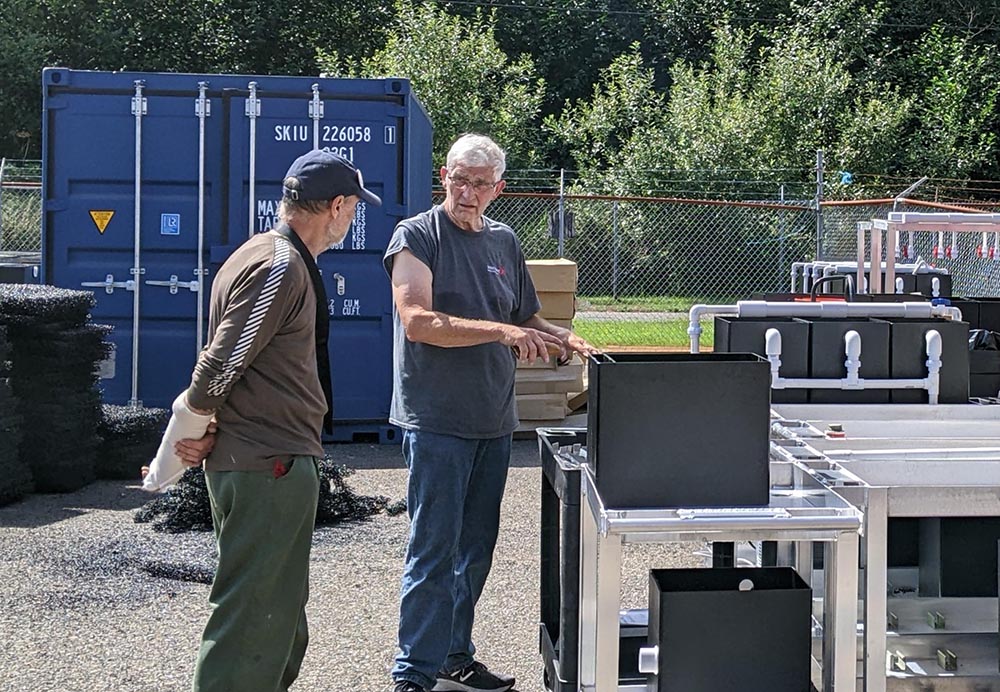
After a career of over 30 years in the non-profit hatchery movement in Alaska and Oregon, Tod Jones was looking forward to retirement—until he had a “eureka” moment in 2019 while visiting a salmon hatchery near Hood Canal in northwest Washington.
He had been invited by members of the Skokomish tribe to advise them on ways to improve their output of around a million salmon eggs per year, but found there was very little room for expansion: the hatchery was built into a steep slope above a creek that provided a reliable supply of gravity-fed water.
“That was where I first had the idea of prefabricating a complete hatchery in a 40-foot shipping container,” he told me when I stopped by his workshop on the east side of Astoria, Oregon.
Surrounded by containers, incubation boxes and pipes, he explained how he had been developing his ideas for a new type of incubator for many years, making small improvements in the traditional vertical tray and trough system, then testing them in the field.
The result of this experimentation was a proven design using free-standing HDPE (high density polyethylene) boxes 18-24 foot square and 24-30 inches tall to house the salmon eggs or fry.
He had developed various drop-in horizontal plates to allow passage of the fry and create the best possible water circulation. The standard box by Redd Zone (a company founded by Jones that he’s the CEO of) can be fitted out to become either an egg-eyeing station of an incubator for the sack fry.
The mobile egg-eyeing station is built on a sturdy aluminum trolley with 2-3 boxes and all plumbing, valves, wiring and switches installed. The reservoir and the electric equipment are placed on the lower shelf.
The order that he was completing featured a Danner Mag-drive 500 gph pump and a 10,000 BTU/hr (1 hp) Penguin chiller. This gives a 20 degree Fahrenheit temperature drop in two hours using recycled water, ideal for otolith marking and/or retarding development.
The precise control of the apparatus leads to egg development of a maximum of 225,000 Chinook eggs or 275,000 Cohoe, according to Jones.
The Best Fry Swim Out incubator system utilizes the same boxes lined up along each side of the 40-foot container with an 8-inch PVC supply pipe running above each bank.
The boxes are divided into three separate levels by aluminum plates: the small fry are poured into the top compartment where they remain until their egg sac shrinks enough to let them swim through a slotted plate with various size openings available for different species.
In the large middle compartment, the fry settle into several layers of Black Matala—a unique plastic medium that consists of a tangle of thin fibers in the shape of a rigid slab two inches thick. It was originated for filtration in koi tanks and aquariums, but the manufacturers also recommend it as a spawning substrate and for use in shrimp, crab and mollusk tanks.
The fry grow quickly in this environment until they mature, and are able to swim down through the slots in the floor plate and outside to the next stage of their growth. The entire system can then be flushed and hosed out using standard garden hoses and fittings. This dramatically reduces some of the most time-consuming tasks, like cleaning and disinfecting the system, Jones pointed out.
Fish eggs mature very quickly, but streamlining the assembly process for a full Redd Zone system took considerable trial and error before Jones could confidently order all the materials and contract with a machine shop that could CNC cut the hundreds of pieces required to his specification.
After the first 40-foot container with a 5 million egg capacity was delivered to the Skokomish tribe, Jones began to receive more enquiries from Washington hatcheries. This resulted in sales of six 20-foot containers to tribal schools like the Quinault Indian Reservation on the Pacific coast, so their students can learn to run the operation on campus.
This was followed by a second 40 for another tribe with a capacity of 5.4 million eggs per year. These sales encouraged him to set up a new workshop with sufficient space to store several containers, and develop more efficient assembly methods.
Jones said he hasn’t put much effort into marketing his products, feeling that having systems around the state that are actually working is the best form of promotion. His latest model includes LED overhead lighting and skylights, giving the technicians maximum control over egg and fry development.
“They can be built to order and delivered to any site with road, water or even helicopter access, ready to install,” Jones remarked.
This certainly looks like a real breakthrough in fisheries technology, and deserves to become part of the regional effort in the Pacific Northwest to ensure salmon survival. For more information, visit https://reddzone.net/.
